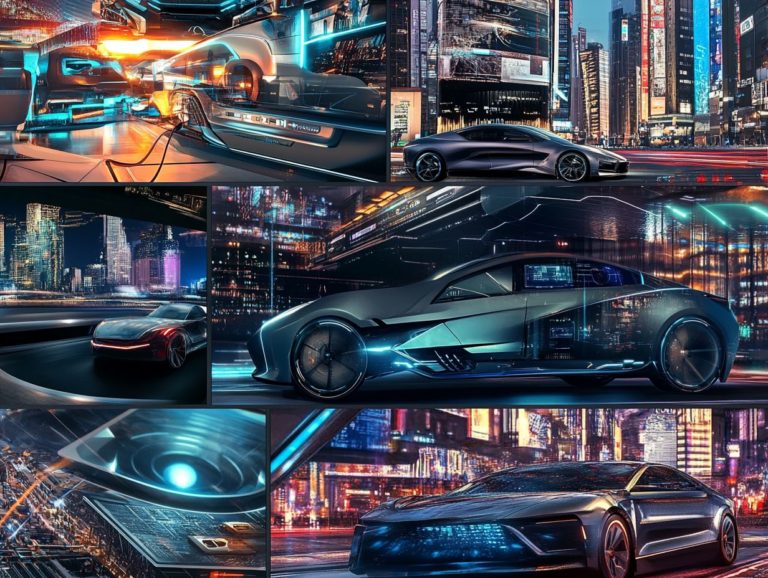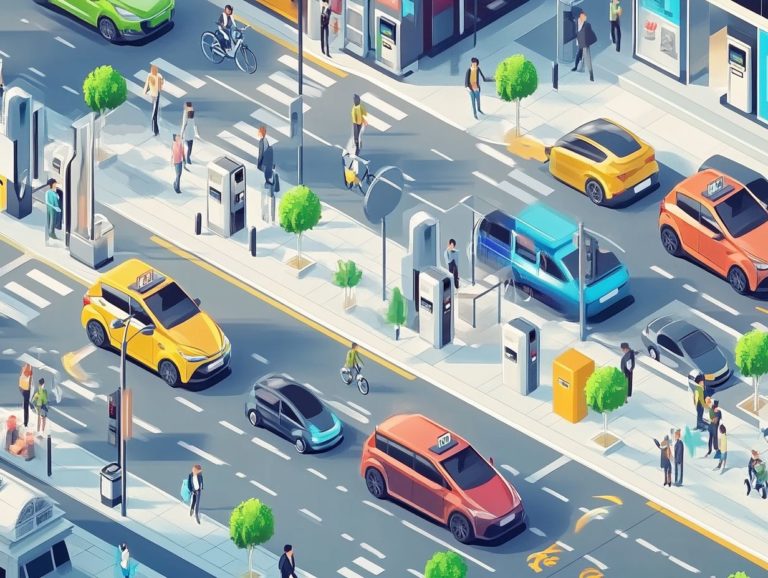How Charging Infrastructure is Evolving Globally
As electric vehicles (EVs) gain momentum globally, the significance of a robust charging infrastructure becomes increasingly clear.
This exploration delves into the complex landscape of charging solutions, examining the current state, global trends, and the driving forces behind its growth.
You ll uncover the challenges that hinder the development of accessible, affordable, and compatible charging options. Government initiatives and technological advancements are also highlighted as they shape the future.
This discussion invites you to envision what lies ahead for charging infrastructure. It paints a picture of what EV users can expect in the near future.
Contents
- Key Takeaways:
- Overview of Charging Infrastructure
- Current State of Charging Infrastructure
- Factors Driving the Evolution of Charging Infrastructure
- Challenges and Solutions
- Future of Charging Infrastructure
- Frequently Asked Questions
- What is charging infrastructure and why is it important?
- How has charging infrastructure evolved over time?
- What are the major challenges in the global evolution of charging infrastructure?
- Are there any initiatives being taken to improve the global charging infrastructure?
- How is the evolution of charging infrastructure impacting the electric vehicle market?
- What does the future hold for charging infrastructure globally?
Key Takeaways:

- Charging infrastructure is not just important; it’s the backbone of the electric vehicle revolution!
- Environmental concerns, advancements in technology, and government initiatives are key drivers of the evolving charging infrastructure globally.
- Despite challenges such as accessibility and compatibility, the future looks bright with potential developments in the industry.
Overview of Charging Infrastructure
The charging infrastructure is a vital pillar of the electric vehicle (EV) revolution, highlighting the impact of charging infrastructure on EV adoption and establishing the essential framework for electric mobility.
Battery capacities are improving. New charging methods like Level 1, Level 2, DC fast charging, and wireless options are emerging, evolving the landscape at a remarkable pace.
Sustainable solutions, like solar-powered charging stations and smart-grid integration, are increasingly becoming integral in addressing the charging needs of both consumers and commercial fleets alike.
What is Charging Infrastructure?
Charging infrastructure encompasses the systems and technologies that deliver electric power to electric vehicles. This includes various charging stations developed by companies like Tesla and General Motors.
These stations fall into three primary categories: Level 1, Level 2, and DC fast chargers, each offering unique charging speeds and applications. Level 1 chargers typically utilize standard household outlets, providing slow charging that s perfect for overnight use.
In contrast, Level 2 stations offer a quicker charging experience and are often found in public places like shopping malls and workplaces, making it convenient for you to charge while you go about your day.
DC fast chargers are strategically positioned along highways and major travel routes, significantly reducing charging time and supporting your long-distance journeys.
Various companies contribute to this ecosystem by manufacturing charging hardware, developing software for station management, or operating the infrastructure all playing vital roles in promoting electric mobility and ensuring a seamless experience for drivers like you.
Current State of Charging Infrastructure
The current landscape of charging infrastructure showcases remarkable advancements in public charging stations, reflecting the evolution of public EV charging infrastructure and the broader evolution of electric mobility.
Statistics indicate a rapid surge in both the number of electric vehicles on the road and the charging infrastructure that supports them, highlighting a promising future for sustainable transportation.
Global Trends and Statistics
In 2022, the global EV market soared to unprecedented heights, with electric car sales hitting record numbers. This remarkable growth was fueled by increasing awareness of climate change and the pressing need for sustainable transportation solutions.
This surge indicates a significant shift in consumer behavior, as more individuals prioritize eco-friendly options in their purchasing decisions. Recent statistics show that EV sales surpassed 10 million units worldwide an impressive trend supported by government incentives and advancements in battery technology that enhance both range and affordability.
Market analysts highlight that younger generations are particularly attracted to electric vehicles as part of a wider commitment to sustainability. As these dynamics evolve, the automotive industry’s transition to electric vehicles is ready to dramatically lower carbon footprints and redefine urban mobility in line with global climate objectives.
Factors Driving the Evolution of Charging Infrastructure

Several factors shape the evolution of charging infrastructure: heightened environmental concerns, groundbreaking advancements in technology, and proactive government initiatives work together to address the challenges of charging infrastructure expansion and accelerate the adoption of electric vehicles.
Environmental Concerns
The environmental impact of fossil fuels has sparked awareness of climate change, pushing people toward sustainable energy solutions like electric vehicles and the essential charging infrastructure.
As the harmful effects of traditional transportation methods become more evident, communities explore alternatives that promote lower emissions and healthier ecosystems. The urgency to tackle air pollution and reduce carbon emissions has ignited innovations in electric vehicle technology, making it more accessible and enticing for everyday use.
Both governments and private sectors recognize the critical need to invest in robust charging networks. This ensures necessary resources for a seamless transition to electric mobility in daily life. Embracing this shift helps address pressing environmental challenges and encourages a transformative rethink of societal attitudes toward transportation.
Advancements in Technology
Recent advancements in charging methods, battery manufacturing, and fast charging technology significantly improve the availability of charging stations, including innovative reservation systems.
These innovations enhance efficiency and provide a seamless experience for recharging electric vehicles. With the rise of ultra-fast charging stations, you can power up your battery in a fraction of the time, making long journeys less stressful and more accessible.
Improvements in battery technology such as higher energy density (the amount of energy stored) and extended lifespan reduce overall costs associated with charging and maintenance. Ultimately, these enhancements transform your experience, offering a more sustainable and convenient option for mobility in today s fast-paced world.
Government Initiatives
Government initiatives, especially those led by the Federal Highway Administration, are crucial in establishing international standards and advancing electric mobility through expanding charging infrastructure.
These programs boost the number of charging stations in urban and rural areas while streamlining regulations that simplify access for consumers and businesses.
By collaborating with a diverse array of stakeholders, including local governments and private sector partners, these initiatives nurture a robust electric vehicle ecosystem. They aim to reduce range anxiety for potential EV buyers, highlighting the need for a dependable and extensive charging network that can significantly drive the adoption of electric vehicles.
Ready to embrace the electric revolution? Learn more about how you can make a difference today!
Challenges and Solutions
Despite notable advancements in charging infrastructure, persistent challenges deserve attention. Issues such as accessibility, affordability, and the pressing need for standardization and compatibility (meaning different charging systems can work together) remain critical obstacles that must be addressed to effectively support the adoption of electric vehicles.
Accessibility and Affordability

The accessibility and affordability of charging stations play a crucial role in the widespread adoption of electric vehicles. Concepts like paying for charging services are emerging to enhance the availability of public charging stations.
This model tackles financial barriers that often accompany traditional charging infrastructure. It paves the way for innovative partnerships between businesses and service providers. As cities strive for sustainability, integrating such solutions becomes essential to ensure you have reliable access to charging points without facing exorbitant costs.
By leveraging the latest technology and offering flexible pricing plans, these new business frameworks can significantly lower entry barriers for you as a consumer. This fosters greater confidence in electric vehicles and encourages a collective shift towards a more electrified future.
Standardization and Compatibility
Standardization and compatibility among various charging systems, like the Combined Charging System (a universal charging standard) and CHAdeMO (a fast charging solution), are essential for ensuring smooth operation within the charging infrastructure ecosystem.
This collaborative approach not only enhances your convenience but also encourages the widespread adoption of electric vehicles by easing range anxiety. As more EVs enter the market, incompatibility between different charging technologies presents significant challenges. You might find yourself frustrated at incompatible stations or facing delays due to limited access.
For manufacturers, developing multiple versions of charging adapters can lead to increased costs. Therefore, prioritizing a standardized framework is crucial for improving overall efficiency, reliability, and your experience in the rapidly evolving world of electric vehicle charging.
Future of Charging Infrastructure
The future of charging infrastructure is rapidly evolving, propelled by emerging trends in technology, interdisciplinary collaboration, and groundbreaking solutions from influential players such as Zuken in the EV market. You stand at the forefront of this evolution, witnessing how these dynamics will reshape the landscape of electric vehicle charging, as highlighted in the latest developments in EV charging networks, paving the way for a more efficient and accessible future.
Predictions and Potential Developments
Predictions for the future of charging infrastructure suggest you can expect remarkable advancements in charging power, as well as insights into the role of charging stations in EV ecosystems, tailored to various consumer needs!
As the demand for electric vehicles continues to rise, innovations in rapid charging technology are set to emerge, transforming the process into something quicker and more efficient. The integration of smart grid technologies will likely enhance energy management, enabling seamless communication between charging stations and the grid.
You might also notice market shifts, with increased investments pouring in from automakers and energy companies into both public and private charging networks. These developments promise to improve accessibility and support the widespread adoption of renewable energy sources, ultimately making electric mobility more sustainable and appealing to an even broader audience.
Frequently Asked Questions
What is charging infrastructure and why is it important?

Charging infrastructure refers to the network of charging stations and equipment that allow for the charging of electric vehicles. Supporting the growth and adoption of electric vehicles globally is crucial, and understanding the importance of sustainable EV charging solutions can help reduce reliance on fossil fuels.
How has charging infrastructure evolved over time?
Initially, charging infrastructure was mostly slow chargers used at home. Now, quick chargers are on the rise, making public charging stations more common.
What are the major challenges in the global evolution of charging infrastructure?
A big challenge is the high cost of setting up and keeping charging stations running. This can stop private companies from investing.
There is also the problem of compatibility between different charging systems, which makes it tricky for drivers to find the right station.
Are there any initiatives being taken to improve the global charging infrastructure?
Yes, many groups, including governments and companies, are working to enhance charging infrastructure. They are launching funding programs, partnerships, and awareness campaigns.
How is the evolution of charging infrastructure impacting the electric vehicle market?
Having enough charging stations is crucial for getting more people to buy electric vehicles. As charging options grow, more people will likely make the switch.
What does the future hold for charging infrastructure globally?
The future is bright for charging infrastructure! New technology is making charging faster and more efficient, with innovations like the future of EV charging stations and exciting wireless charging options.






